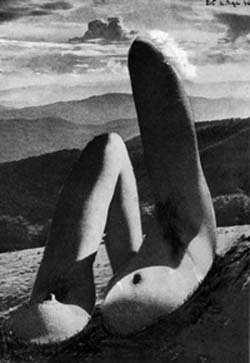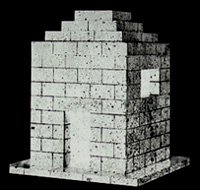 LOOKING AWRY
LOOKING AWRYREVERSE ARCHITECTURE
ERASING THINGS - It is the premise of Landscape Agency New York that architecture currently needs to be quite literally taken apart, reversed as it were, to reveal everything else, every thing repressed by its massive (and architectonic) gravitas. As an archive, architecture (hopelessly reified as /Architecture/) includes its own holes, elisions, etcetera (despite claims otherwise). Such things are, in fact, NOT things at all, but are (indeed) systematic destructions of what is ‘given’ (in the sense that environments contain and include what is ‘purely given’, the ‘as such’ problematized in metaphysical arguments (and putative ontological arguments), yet a something else that is essential to all experience. Therefore, it is suggested that architecture constitutes a special problem today, even as it disowns it very own yesterday (as it almost always does to qualify its present-day coordinates).
Image (above) - Karel Teige, "Collage 316"
These repressions are part and parcel of /Architecture/’s hegemonic status as a constructed form of the machinic (de-natured) ‘nature’ of Modernism and its very own (in)significance vis-à-vis everything else. The ‘as such’, as such, is the measure of milieux (topologically-inflected thought), which includes anti-milieux. Thus, Tristan Tzara’s “Knowledge, knowledge, knowledge / Boom boom, boom boom, boom boom” resonates outside of the historical Dada Manifesto insofar as /Architecture/ is 'Thought Itself' writ large. Such architectures as elude the grasp of the hegemonic nature of repressive systems are, therefore, to be prized, whereas those that signify merely nothing (the stuff of nightmares) are to be reversed (pried open), and all things contained within them (flattened and/or de-natured) freed (given ‘free reign/rein’). There is no other way out of this stalemate. It should be noted, however, in passing (but intrinsically so) that this agenda has absolutely nothing in common with the agenda of so-called 'architecture without architects' (Rudofsky, et alia) or Christopher Alexander's backward-leaning and somewhat embarassing architectural patois (the Pattern Language thing). Such an agenda does have, on the other hand, much in common with the extraordinary investigations of architectural form carried out by John Hejduk and Raimund Abraham (intitially in the 1970s) and the phenomenologically inspired works of architects and non-architects laboring in the vineyards of architectural representation (against the dictates of the more profoundly disturbing thing often called everyday architecture). In this regard, feel free to go directly to Linguistic Dust for a crash course in architectural formalism. Or, if you wish, you may cut to the chase and follow the winding path of Sublime Potential, a serial essay, and a linguistics-inspired dive straight into architectural representation and misrepresentation. Of the latter, it is best to merely point out the most reprehensible examples and pass by. Should you care to pursue apoplectic disingenuity (ludic paratactics!), please visit the always-mutating Anti-Journal.
 The documents spread out over the 15 MB web site LANY ARCHIVE-GROTTO represent this quixotic (and exotic) search for Some-thing Else (often mockingly reified as /S/ome-thing Else), an approach (and nothing more!) to what is often referred to as the Sublime (which is nothing more and nothing less than a problematic inherited from outmoded aesthetical and metaphysical thought). This Some-thing Else is presented herein as the scintillating (non)thing (nothing) of systems and topological forms of design and thought that resist and reverse the architectonic and de facto auto-da-fé of /Architecture/ as an ideological system in service to the machine that is slowly (and methodically) destroying ‘experience’ (here denoted in the fullest sense of the word, and in the sense intended by Giorgio Agamben in his book Infancy & History: Essays on the Destruction of Experience). While this quest for Some-thing Else includes forays into contemporary architecture, urbanism, and the thing otherwise known as landscape architecture (a something no one seems to be able to define), it also requires a rigorous assault on allied conventions and disciplines including art, philosophy, politics, cinema, and literature. Notable in this regard, then, is the extraordinary work of Jean-Luc Marion. If Marion's concept of 'saturated phenomena' resembles everything repressed within the folds of /Architecture/, this resemblance is of a 'family' type -- and, if this foray into the 'nature' of saturated phenomena resembles a deep-sea dive toward something buried in time (time immemorial), it is because such a profound sounding of the depths is, in fact (and after all), a sounding of everything repressive.
The documents spread out over the 15 MB web site LANY ARCHIVE-GROTTO represent this quixotic (and exotic) search for Some-thing Else (often mockingly reified as /S/ome-thing Else), an approach (and nothing more!) to what is often referred to as the Sublime (which is nothing more and nothing less than a problematic inherited from outmoded aesthetical and metaphysical thought). This Some-thing Else is presented herein as the scintillating (non)thing (nothing) of systems and topological forms of design and thought that resist and reverse the architectonic and de facto auto-da-fé of /Architecture/ as an ideological system in service to the machine that is slowly (and methodically) destroying ‘experience’ (here denoted in the fullest sense of the word, and in the sense intended by Giorgio Agamben in his book Infancy & History: Essays on the Destruction of Experience). While this quest for Some-thing Else includes forays into contemporary architecture, urbanism, and the thing otherwise known as landscape architecture (a something no one seems to be able to define), it also requires a rigorous assault on allied conventions and disciplines including art, philosophy, politics, cinema, and literature. Notable in this regard, then, is the extraordinary work of Jean-Luc Marion. If Marion's concept of 'saturated phenomena' resembles everything repressed within the folds of /Architecture/, this resemblance is of a 'family' type -- and, if this foray into the 'nature' of saturated phenomena resembles a deep-sea dive toward something buried in time (time immemorial), it is because such a profound sounding of the depths is, in fact (and after all), a sounding of everything repressive.The pages of the ARCHIVE-GROTTO are offered gratis (though it is nice to hear from readers), with the expectation that all things being secretly headed toward some manner of sublime synthesis, this synthesis needs to be founded on the most extraordinary and edifying premises possible versus the more or less bankrupt premises (broken promises) of /Architecture/ as a singular discipline and media as the compensatory escape route for anyone looking for a way out. Notwithstanding the production of personal utopias, it seems more apt (and far more persuasive) to offer, instead, a non-nostalgic 'return' to that which lies bruised and bleeding beneath the on-rolling architectural machine.
GK (08/26/04)
 POSTSCR(Y)PT
POSTSCR(Y)PTImage (right) - Adolf Loos, "Tomb for Arnold Hauser" (Sketch / inverted image)

